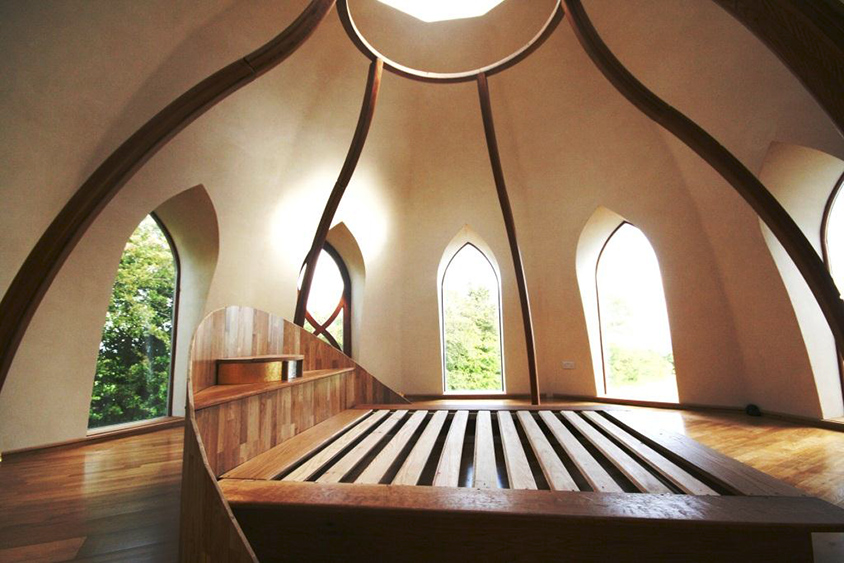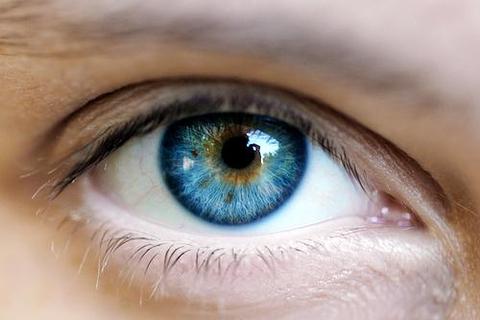
Written By Michael Rice
In order to begin to understand the potential of Bioarchitecture in terms of health and well-being, it makes sense to explore how the brain and nervous system respond to stimuli from and in our environment. One of our primary senses is seeing, as this is usually the predominant vehicle for our experience of physical space, at least initially.
Perception can be defined as the process of attaining awareness or understanding of the environment by organising and interpreting sensory information. All perception involves signals in the nervous system. How we perceive the space around us initiates a physiological response which is part of a holistic process which can generate feelings of relaxation, joy and an overall sense of comfort. It can also create stress, discordance and a sense of discomfort, especially if the space is visually discordant.
A very interesting field of study has emerged in recent years called neuroesthetics, which is an attempt to combine neurological research with aesthetics by investigating the experience of beauty and appreciation of art and other visual stimulus on the level of brain functions and mental states. Researchers in this emergent field combine principles from perceptual psychology, evolutionary biology, and neurological potential and functional brain anatomy in order to address the interpretation and meaning of beauty which may underpin the essence of art and architecture.
It has been said that beauty is in (or perceived through) the eye of the beholder and it is here, with this remarkable organ of perception that we shall begin our journey into the world of seeing. In essence, the eye detects light and converts it into electro-chemical impulses in the brain. It collects projected and reflected light from the surrounding environment, regulates its intensity through the iris diaphragm, and focuses it through a flexible and adjustable assembly of lenses to the cells in the retina at the back of the eye.

The retina contains two major types of light-sensitive ‘photoreceptor’ cells used for vision: the rods and the cones, called that because of their shape. In essence the rods respond to light and dark, as they contain a chemical pigment which is sensitive to low light intensity. The cones are responsible for colour vision, differentiation and depth perception, and are able to receive and respond to different frequencies of light.
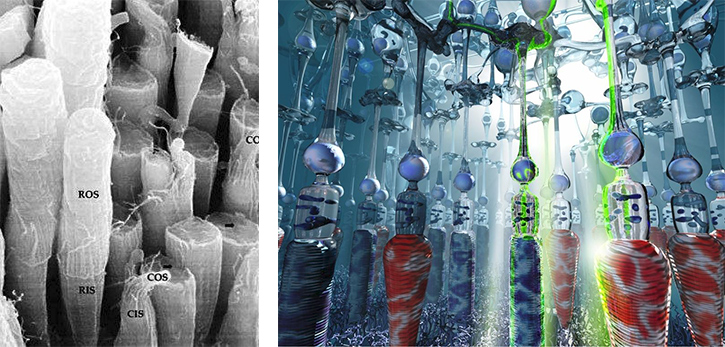
When light hits the pigments in the retinal nerve cells (which are considered part of the central nervous system), chemical reactions occur, triggering a cascade of electrical signals which travel along the axons (filamentous fibres) until they reach the ends of the cells, and connect with other chemicals which are stored in little cellular bio containers, called vesicles. At this stage the chemicals in these sacks are released into the interspaces between the brains nerve cells. This is how the reflected light is transformed into an electrical signal that leaps and hops from one nerve cell to the other distributing itself to many regions of the brain.

The primary distribution pathway for this process of perception is called the optic tract, which resembles a large cable like structure linking the eyes and the brain, via a crossing point called the optic chiasma, which allows for parts of both eyes that attend to the right visual field to be processed in the left visual system in the brain, and vice versa. From here the signals are relayed to a switching station in the brain stem and finally lead to the part of the brain that governs vision, called the occipital lobe.
This brief description of the anatomy of the eye and how the light from an object initiates electrical and chemical signals, creating an image in our awareness is only part of the process of perception.
Overall perception is shaped by learning, memory and expectation, and depends on many complex functions of the nervous system occurring mostly outside of our conscious awareness. For instance, before we recognise an object, our eyes see only bits and pieces of it, in effect presenting contrasting edges and geometric lines of form. There is not enough information available to make a continuous line but the brain does an amazing job of connecting the dots and filling in the blanks.
During this process, other parts of the brain are actively and rapidly seeking to match the information with memorised patterns held in storage, and when there is a resonance the link ignites and we recognise (re-cognise, to know again) what it is we are looking at. Depending on what pattern is chosen, different parts of the brain light up, blood flow increases, proteins are formed and utilised, chemicals are released and distributed and nerve cells fire and signal to one another.
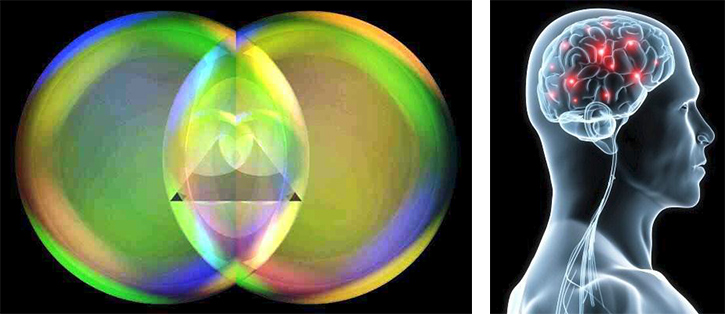
Faces are recognised by one part of the brain (the fusiform face area) and objects by another. Live images of the brain using various scanning apparatus display activity in specific areas corresponding to the interpretation of what is being observed. For example, the prefrontal cortex of the brain is previously known for its roles in the perception of coloured objects, decision making and memory, but recent studies have also linked it to the conscious aesthetic experience because it is activated during tasks such as determining the appeal of visual stimuli. The intensity of the electrical activity in this region, specifically the prefrontal dorsalateral cortex, peaks when we are observing a beautiful work of art or perceiving / experiencing a harmonious space.
What is very interesting and relevant to our discussion is that there is a specific part of the neuronal network of the brain that specialises in perceiving and recognising buildings, or other large structures or forms that are being viewed from a limited array or perspectives. The location of this part of the brain is below the parahippocampal place area, which plays an important role in the encoding and recognition of scenes. This part of the brain becomes highly active when we view topographical scene stimuli such as large physical structures, cityscapes and rooms or enclosed spaces.
Recent research indicates that the brain uses larger structures such as buildings to map and define the geometry of the local space. When we first look at a scene we are simultaneously forming a contextual narrative of the space whilst also mapping the primary form in terms of shapes, parameters, boundaries and limits.

So how can the scene being viewed and experienced affect us in terms of our feelings of health and well-being? Is there something about the scene that might be discordant or stressful, in terms of how we relate and respond to it?
Science has discovered that there is a pathway at the base of the brain that connects the visual cortex to the parahippocampal place area, forming a connection between where the retinal signals are first received and the where they are assembled into the perception of a scene. Along this path way are nerve cells, which express an increased density of receptors for the morphine-like molecules called endorphins. Research has proven that when people view a natural and beautiful scene or geometrical presentation, the nerve cells in the opiate rich pathway become very active. The resulting biochemical release represents a natural high being gifted to you by your own brain in direct response to the scene being viewed and experienced. So what is in the scene that creates this effect, and is it the objects themselves, or the arrangement of them in space?
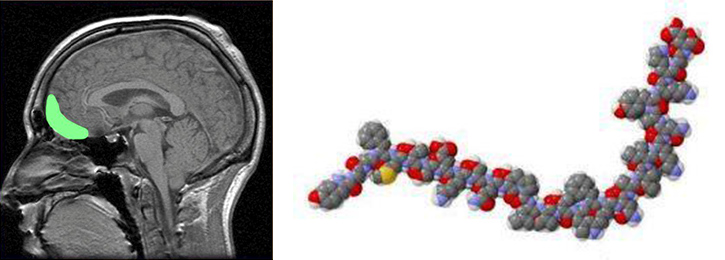
Some wonderful work done by researchers in Kyoto University in Japan demonstrates how the geometry of a space, place or scene can suggest a pleasing picture to our subconscious which creates measurable effects in the brain resulting in feelings of connection, groundedness and health / well-being. The study involved symmetry calculations of the five irregular rock clusters in the Ryoan Ji Zen temple and garden, which are arranged and positioned in a sea of racked gravel. The entire scene was designed to be viewed from the hall of the temple, which is located off centre to the left of the garden. The calculations involved analysing the axes of symmetry within and between the groups of rock, using a method called medial-axis transformation. When the resulting geometrical pattern was generated and reviewed the researchers made a remarkable discovery.

The axes formed the fractal geometry of a tree, with the trunk passing directly through the primary viewpoint of the temple. The natural branching algorithm extended out and contained each of the rock clusters, in an effortless evolution of visual science. When the process was repeated with random groupings of rocks the pattern failed to materialise. So it would seem that the designers of this garden, priests and meditators, were able to place these points of visual focus in an overall matrix that directly mirrored a fundamental generative natural expression, and once which it would seem our perception is wired to react positively to.
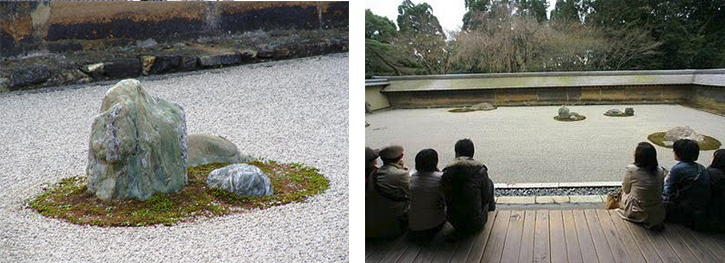
I recall sitting there in the sweet spot of perception in this garden, and feeling totally engrossed in the entire scene. There was a sense and feeling of outer calm and repose, which successfully covered an intensity of timeless attention that felt at once omnipresent and totally captivating.
Fractal patterns, displaying as self-similar branching forms, are seen at every level and scale in nature, from atomic radii, snowflakes, trees, mountain ranges and galaxies.

It is found in the shape and form of the human body, and expresses in the cascading geometry of nerve cells, alveoli in the lungs, blood vessels and even in the folds of the brain itself.

Fractal geometry often utilises the infinitely recursive and self-referencing geometry of Phi, also called the Golden Ratio or Sacred Cut. This ratio and its relatives form the basis of bioarchitecture design protocol, providing a natural matrix for the evolution of space and form in direct alignment with the movement most sought by life and living systems.
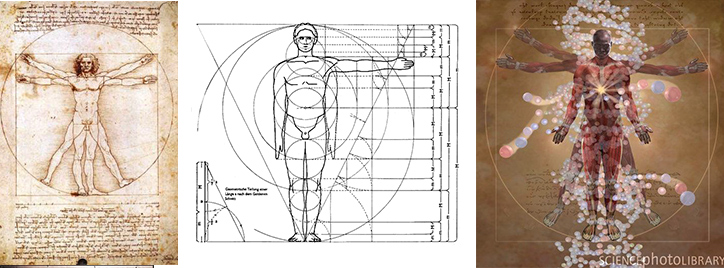
The timeless graphic of Leonardo’s ideal man is well known and points to a recognition of the inherent proportional harmonic of the human body. It may have been the visual inspiration that prompted the pioneering work of Californian plastic surgeon Dr. Stephen Marquardt who revealed that a phi based proportional precision under pinned the perception of perfect beauty in the human face. He collected photographs of faces of the world deemed to be beautiful and began measuring their dimensions. The golden ratio was everywhere, displaying itself in the relationship between all the elements and features of the face.

‘Beautiful’ people’s mouths were 1.618 (golden ratio expressed as a number) wider than their noses, and the nose itself was 1.618 times wider than the tip of their noses. Before you look in the mirror and start neurotically measuring your face it is worth mentioning that nature likes to approximate, in
a playful movement towards aligning all the energies to handle change whilst maintaining a healthy and overall attractive average.
Another very revealing study which is worth mentioning here was carried out by scientists and mathematicians who went on a mission of discovery to a South American forest. They were given permission to cut down a tree and carry out a very detailed survey of the tree, imputing the data into a computer program which was able to accurately map the fractal geometry / branching algorithm of the tree. They then chose a larger surrounding area of the forest and proceeded to measure all the trees contained in that area, concentrating primarily on the width of the trunks. What they discovered was that the specifics of the fractal geometry of the single tree that was cut down and measured accurately mirrored the distribution of the differing tree thicknesses in the studied area.
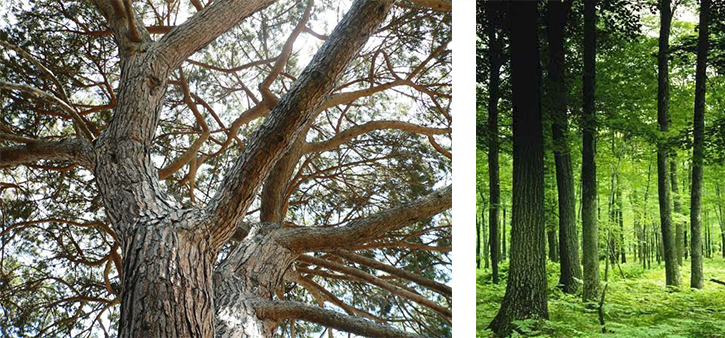
In simple terms the pattern of the entire area was fractally mapped onto one tree, showing that the part contains the information necessary to describe the whole. This amount of context reference is astounding, and points towards the ability of nature and natural forms to store and distribute information effortlessly at any scale.
We cannot say for sure why it is that repeating patterns at different scales are pleasing to the eye (and brain / body). There are many theories, most of which point to the reasonable proposal that fractals are intrinsically satisfying to the human mind. When we view or perceive a scene that consists of fractal structures and arrangements, our mind responds to the complex, repetitive, self-similar increasing-decreasing patterns.
The fractally harmonic context rich visual experience creates a perception process which releases bio chemicals that manifest feelings of health, happiness and well-being. When the mind, which is in essence the process of regulating the flow of energy and information, is freed from the rigid boundaries created by boxed scaling, it can move through the doors of perception at will.

It is not that cubic or regular orthogonal spaces are ‘bad’ for us; unless they have been specifically designed to be so. Indeed if the proportions are ‘correct’ then one can derive a positive reaction from being in it, even if they are not necessarily based on specifically phi harmonics. Rather it is when all of the design elements present themselves in any fractal form that the effect is felt and benefitted from.
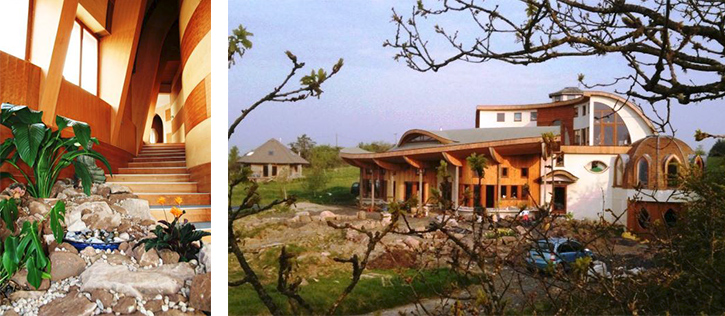
So when we design and create a space that is based on the fractal geometry of nature, nesting shapes, forms and ratios in a physical construct, our senses are activated in a holistic integrated way which our brains and bodies find pleasing. This sensory ease facilitates the generation and experience of feelings that are the foundation of health and happiness. If we extend this principle into other realms of sensory perception, such as the overall shape of the space, the quality of light and use of colour, the texture of the materials, the sounds etc., we can increase and enhance the physiological and psychological effect dramatically.

As new born infants, eager to develop and evolve, we are hard and soft wired to be attracted to the face and breasts of our mother, which are perceived as fractal geometric symmetries. This attraction is absolutely vital to the optimal emergence of consciousness, awareness and intelligence. As an extension of this innate instinct we are naturally drawn to place our attention and focus on shapes that are curved, naturalistic in form and fractal in structure.
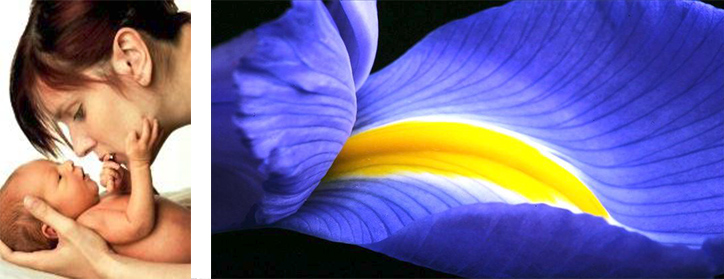
When we add to this the fractal potential of time as well as space, we can formulate a generative movement to emergence, where focussed ritual and intention are nodal symmetry operations anchoring the whole process in a way that life is particularly attracted to. When amplified further by the addition of others sharing the process the eventual energetic profile of the space becomes very rich in terms of all the fields of information that can embed and dance within the space non-destructively.

There are many examples of structures and art works from the past which incorporated all of these elements in a dance of fractal resonance; from ancient gathering spaces, gothic cathedrals and Indian temples to jewellery, pottery and paintings. Whenever the elements are brought together naturally and in accordance with the fractal forms of life, the result is something that can be described as beautiful and healing. We have observed this potential many times in the homes and living spaces designed using these principles; with people reporting very positive reactions and experiences when they live and move through them.
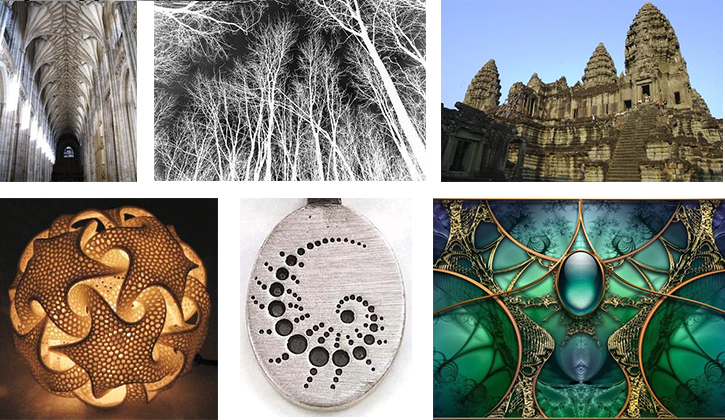
Bioarchitecture has been defined as the art and science of designing and building spaces which create, support and enhance life and living systems. In this regard it would seem that there is a solid basis of evidence to support this definition, at least in terms of how our minds and bodies respond to the shape, form and integrated patterns of space.
Regardless, we shall continue to help people to touch and manifest their ‘HomeDream’, utilising all of the skills available to us, developing our own awareness and ability to perceive and play.
